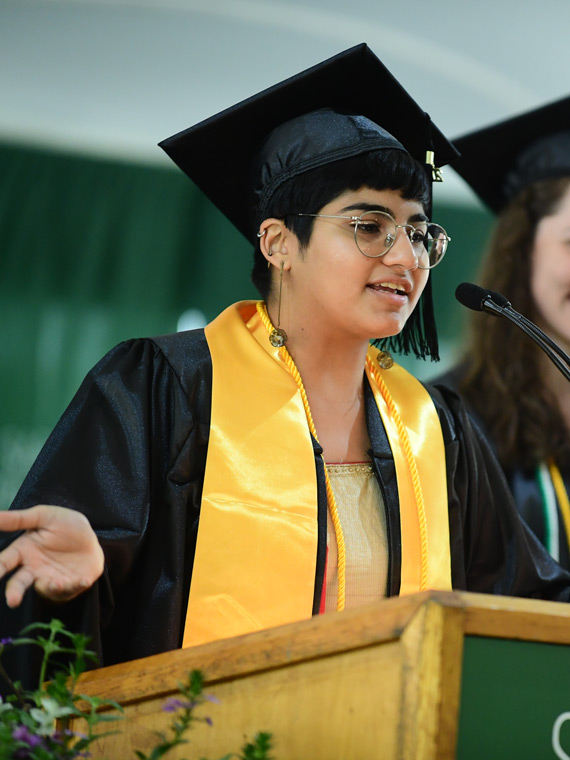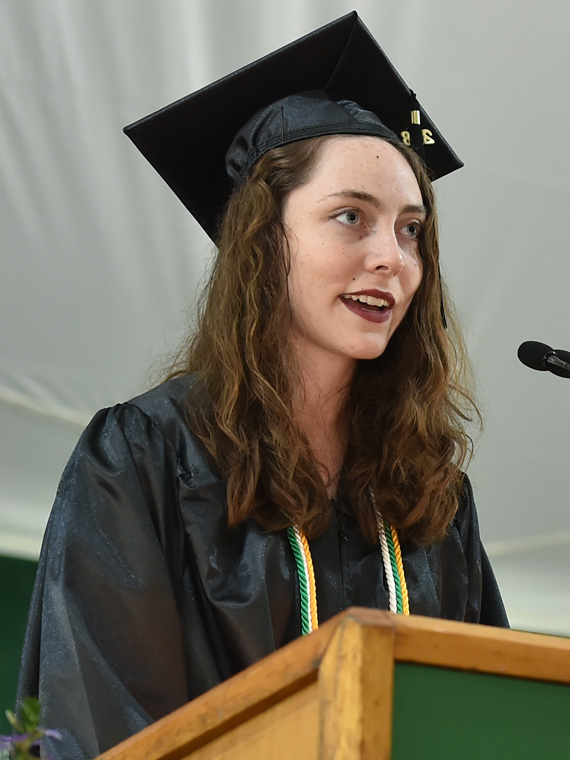Venika Menon ’18
Ever since I found out that I would have the honor to speak here, I have wanted to say something super profound in a foreign language. All I can think of in this moment is “mujhe aam pasand hai.” It just means I love mangos. I hope you find this fact useful!
As I said, it’s an absolute honor for me to be here and I am a little terrified of leaving. As we step into this new and challenging world, I would propose to you that everything we need is under this tent. I am not going to tell you what makes a Sarah Lawrence student special or what skills we have developed here, because we all have experienced it. I just want to remind you of certain people that this institution brought together to make us who we are.
An obvious start would be the faculty who have supported us through our weird conference projects trying to link Hegel’s dialectic and the Kardashians, and pushed us to be better people, not just better students. They are incredible, and we don’t need The Princeton Review to validate that. Though they do agree with us every year. They are the cornerstones of keeping the spirit of a curiosity fueled, self-directed learning alive at this school. They have the kind of enthusiasm for their subject and teaching that sometimes, I think if Kim Christensen did not teach here, she would be stopping people in the supermarket to explain Behavioral Economics. They have taught us to challenge every institution, including this one, and they have challenged us. As Luisa Heredia told us during my last class at Sarah Lawrence, “to change the world, we must walk differently in it.” And wow, Sarah Lawrence students sure do walk weird as we step to our own tune, or probably to that of an obscure indie band.
 Moving on to the people we were crammed on a boat with a few nights ago, our classmates. In my four years here, the student body has taken on tasks that I did not know we could take on. On the easier side of the spectrum, some of us have discussed Anderson’s Imagined Communities in class without reading the text. On the tougher side, some of us have organized protests to support unionization for workers on this campus. Like President Judd has said many times during her Inaugural Year, Sarah Lawrence College was not built for most of us—LGBTQIA folk, people of color, or not-rich people—but we are here! With each generation of students, we leave Sarah Lawrence a little better than when we came in and, in this process, we create our chosen family. People who have been there for us in these formative years—seeing us make mistakes in the Blue Room—are not going to leave us after we leave this tent.
Moving on to the people we were crammed on a boat with a few nights ago, our classmates. In my four years here, the student body has taken on tasks that I did not know we could take on. On the easier side of the spectrum, some of us have discussed Anderson’s Imagined Communities in class without reading the text. On the tougher side, some of us have organized protests to support unionization for workers on this campus. Like President Judd has said many times during her Inaugural Year, Sarah Lawrence College was not built for most of us—LGBTQIA folk, people of color, or not-rich people—but we are here! With each generation of students, we leave Sarah Lawrence a little better than when we came in and, in this process, we create our chosen family. People who have been there for us in these formative years—seeing us make mistakes in the Blue Room—are not going to leave us after we leave this tent.
Lastly, I would like to thank the people our class has invited to this gathering. Family and chosen family alike. I would like to take this moment to thank my mom. Growing up in India with a single mother as an only child was not easy. Getting to Sarah Lawrence was not easy. Graduating was not easy. I know many of us have faced similar hardships to be here. Thank you for supporting us through the most challenging and transformative years of our lives, yet!
I want to leave you all with a story from the beginning of this week. As my friends and I wandered the campus one last time, possibly intoxicated, we came upon the site of the Barbara Walters Campus Center. It’s really hard to miss. One of my friends proclaimed, “this pile of dirt will soon be a beautiful building,” and another responded, “we were once piles of dirt, and now we are beautiful buildings.” So here is to the Class of 2018—to being a little more Barbara Walters Campus Center than when we started!
Remarks as prepared for delivery
Arianna Cooper ’18
You thought you were coming here today to receive a “YAY we made it speech,” but don’t worry—that is included in here at some point. I felt that we also would benefit from learning a few fun facts about the elusive platypus.
 But before I dive into the facts, we have to know the species.
But before I dive into the facts, we have to know the species.
The tail of a beaver
Webbed feet of a swimmer
Bill of a duck
Leather jacket of a 90s punk singer
Doc Martens of a self-expressive teen
Mom jeans of a western thriller
But these are no ordinary creatures
By now you probably are questioning my research, and as you should, because my thesis argument, which could have been a conference project, are the similarities of a platypus and typical Sarah Lawrence student.
Similarity 1
The Platypus
Their Bill Gives Them a Sixth Sense.
A platypus’s bill is comprised of thousands of cells that can detect the electric fields generated by all living things. It’s so sensitive that the platypus can hunt with its eyes, ears, and nose all closed, relying entirely on the bill’s electrolocation.
The Sadie Lou Student
At an early age we are crafted to be innovative, flexible intellects. When one option just is not working out, we have the know how to create eight more options in less than the amount of time it would take a person to walk up Bates hill.
Similarity 2
The Platypus
Scientists Thought the First Known Platypus Was a Hoax.
When the first platypus specimen was sent back to England from Australia in the late 18th century, the scientists who examined it thought that someone was playing a trick on them. “It naturally excites the idea of some deceptive preparation by artificial means,” English zoologist George Shaw wrote in the first scientific description of the platypus, published in 1799.
The SLC Student
Similar to the platypus, when a Sarah Lawrence student attempts to apply to a job, their first statement is typically, “If I could just sit down with the person, I could convince them I am the real deal!” I’m sure the platypus back in the 1790s felt the same way.
Similarity 3
The Platypus
Is a Platypus a Mammal or a Marsupial?
The platypus is classified as a mammal. Mammals give birth to live young. Therefore, the platypus gives birth to live young. Or so you would think. The truth, however, is that not all mammals give live birth! The platypus lays eggs, just like birds and reptiles do. It is one of only five species of egg-laying mammals (called monotremes).
Every year, sometime after July, the mature female platypus produces one to three round, leathery eggs. The eggs stay inside her body for about 28 days, after which she lays them in a nest and keeps them warm for 10 more days before they hatch.
The Sarah Lawrence Student
Now I am not going to even try and compare the birthing facts with an SLC student, but I will attempt to juxtapose that like a platypus, we are an extremely unique school, with even more unique people. We are self-directed learners, with a passion and rigor for experimental excellence.
We are the class who has curiously observed the school and its flaws. We noticed where we could start a legacy and we have established our footprint. The class who created a momentary tree house behind the old dorms (until it was deemed dangerous). The class who was able to stress the importance of all gender bathrooms, which is now a reality on this campus. The class who fights for social and environmental justice. A constant battle regardless of location.
We are a class that has raised the bar for all future Sarah Lawrence students and, my mom voice is coming out now, but due to this I am so proud of you all and I cannot wait to see where our leadership will take us.
So to conclude my argument, just as the platypus is an evolutionary miracle, we too can constantly reshape and redefine the definition of normal. To quote my tour guide when I came to SLC, “We’re a little different here, but so are you.”
Congratulations Class of 2018. WE DID IT!
Sources for platypus facts: articles from mentalfloss.com and ipfactly.com; Remarks as prepared for delivery